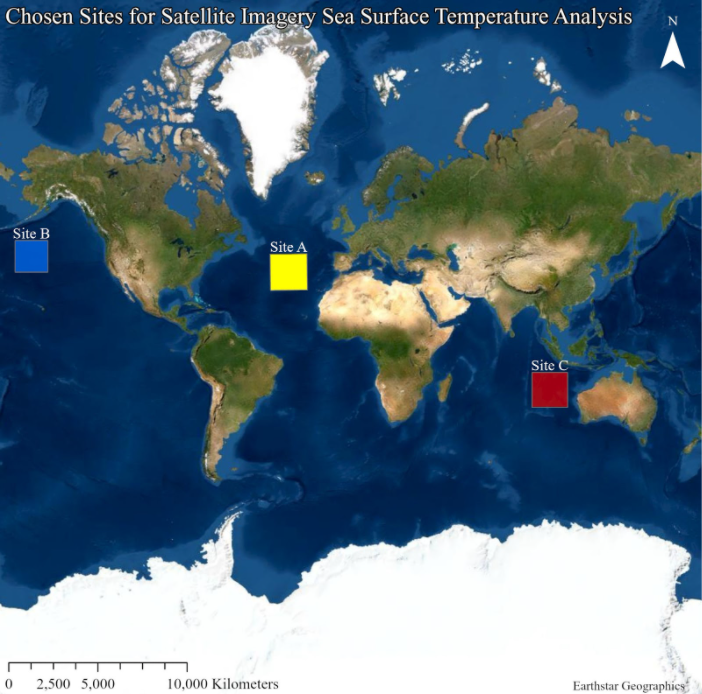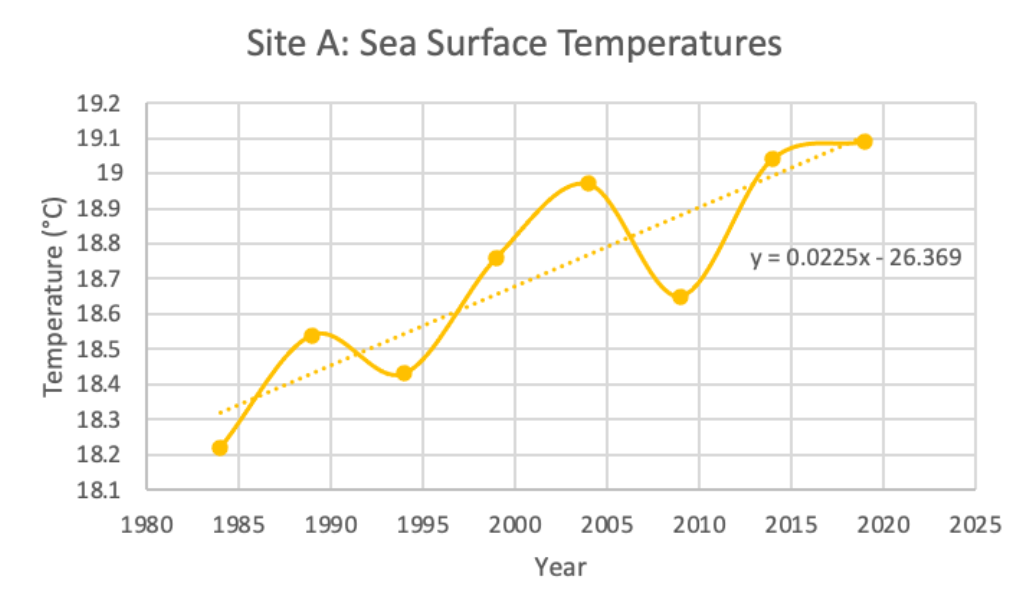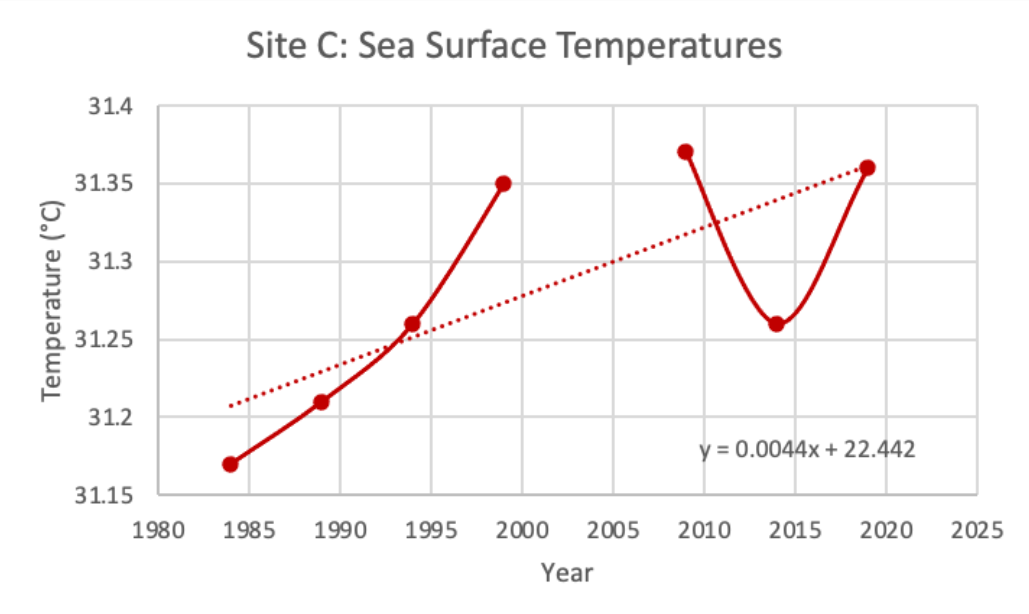Climate Change and Sea Level Rise
Michael Celejewski, Margot Ferguson, Nicholas Skaljin, & Jonathan Spence
Although Earth’s climate system undergoes many natural changes on its own, humans have proven themselves to be capable of causing abnormal atmospheric and oceanic temperature increases, ice melt, and sea-level rise (SLR) (IPCC, 2014). This is the case now more than ever before, and the consequences of this activity are detrimental for both humans and the environment. One of the most apparent consequences of climate change is SLR (Cazenave and Cozannet, 2014), which is influenced by high outputs of greenhouse gases (Tokarska et al., 2019).
Thermal expansion refers to the tendency of matter to increase in volume in response to an increase in temperature (Ratna, 2012). Climate change leads to increased heat content in the ocean, resulting in the thermal expansion of water, and so a rise in sea level is observed. The high projected rates of SLR are concerning for communities residing in areas of low elevation and islands, where coastal erosion could lead to the loss of beaches, property destruction, and mass migration to inland regions (Mimura, 2013). Additionally, SLR will negatively impact a myriad of coastal ecosystems as they become squeezed between human infrastructure and shorelines, reducing the vital habitat for nesting bird and turtle species (Holle et al., 2019).
Our Findings
One way to measure SLR is through satellite image analysis. Using open-source satellite data and imagery analysis software, it is possible to measure sea surface temperature (SST), which provides insight into the thermal expansion of water (Campbell and Wynne, 2011). Satellite programs such as Landsat, which started in 1972, provide huge databases of present and historical imagery (USGS, 2020). This allows for the analysis of SSTs over time, an example of which can be seen below.

Figure 1: A map depicting the chosen sites for satellite imagery sea surface temperature analysis (created by authors in ArcGIS Pro).

Figure 2: A graph depicting the sea surface temperatures over time at Site A based on ENVI analysis (created by authors in Microsoft Excel).

Figure 3: A graph depicting the sea surface temperatures over time at Site B based on ENVI analysis (created by authors in Microsoft Excel).

Figure 4: A graph depicting the sea surface temperatures over time at Site C based on ENVI analysis (created by authors in Microsoft Excel).
Looking at the figures above, a common trend can be clearly identified. At each site, temperatures increased over the past 40 years, and while more thorough analysis is needed to confirm these findings, temperature increases such as the ones found above would lead to thermal expansion and SLR.
Real-World Examples
Miami Beach sits at only 1.20 m above sea level and has consistently been “sinking” over the past century due to SLR (U.S. Census Bureau, 2021). This case study discussed the increase in floods in Miami Beach between 2003 and 2013 through a time series of tidal gauge data. Though this case study was only limited to ten years, there was still an overall increase in flooding and an increase in floods due to extreme weather events—two outcomes directly related to temperature increase within the scope of climate change (Wdowinski et al., 2016). Another case study looked at João Pessoa in Brazil, which is known to experience cyclical phases of erosion and accretion. Thus, the shoreline levels for João Pessoa were analyzed for levels of erosion and accretion from 1985 to 2019 using Landsat satellite data (Santos et al., 2020). It was found that as years progressed, cycles of erosion and accretion became more severe, i.e. later in the time series, both cycles of erosion and accretion were at higher values with respect to earlier data (Santos et al., 2020). This could be due to increased water content in the ocean because of increased temperatures, which causes movement of a large volume of water, and subsequently larger levels of accretion and erosion.
References
Campbell, J.B. and Wynne, R.H., 2011. Introduction to Remote Sensing, Fifth Edition. Guilford Press.
Cazenave, A. and Cozannet, G.L., 2014. Sea level rise and its coastal impacts. Earth’s Future, 2(2), pp.15–34.
Holle, B.V., Irish, J.L., Spivy, A., Weishampel, J.F., Meylan, A., Godfrey, M.H., Dodd, M., Schweitzer, S.H., Keyes, T., Sanders, F., Chaplin, M.K. and Taylor, N.R., 2019. Effects of future sea level rise on coastal habitat. The Journal of Wildlife Management, 83(3), pp.694–704.
IPCC, 2014. AR5 Synthesis Report: Climate Change 2014. [online] Geneva, Switzerland. Available at: https://www.ipcc.ch/report/ar5/syr/ [Accessed 7 Mar. 2021].
Mimura, N., 2013. Sea-level rise caused by climate change and its implications for society. Proceedings of the Japan Academy. Series B, Physical and Biological Sciences, 89(7), pp.281–301.
Ratna, D., 2012. Thermosets. 1st ed. [online] Amsterdam, Netherlands: Woodhead Publishing. Available at: https://www.sciencedirect.com/science/article/pii/B9780857090867500031 [Accessed 7 Mar. 2021].
Santos, C.A.G., do Nascimento, T.V.M., Mishra, M. and da Silva, R.M., 2020. Analysis of long-and short-term shoreline change dynamics: A study case of João Pessoa city in Brazil. Science of The Total Environment, 769, p.144889.
Tokarska, K.B., Hegerl, G.C., Schurer, A.P., Ribes, A. and Fasullo, J.T., 2019. Quantifying human contributions to past and future ocean warming and thermosteric sea level rise. Environmental Research Letters, 14(7), p.074020.
U.S. Census Bureau. 2021. U.S. Census Bureau Quickfacts: Miami Beach City, Florida; Miami City, Florida; United States. [online] Available at: https://www.census.gov/quickfacts/fact/table/miamibeachcityflorida,miamicityflorida,US/PST045219 [Accessed 8 March 2021].
USGS, 2020. Landsat Missions. [online] Available at: https://www.usgs.gov/core-science-systems/nli/landsat/landsat-satellite-missions?qt-science_support_page_related_con=0#qt-science_support_page_related_con [Accessed 1 Mar. 2021].
Wdowinski, S., Bray, R., Kirtman, B.P. and Wu, Z., 2016. Increasing flooding hazard in coastal communities due to rising sea level: Case study of Miami Beach, Florida. Ocean & Coastal Management, 126, pp.1-8.